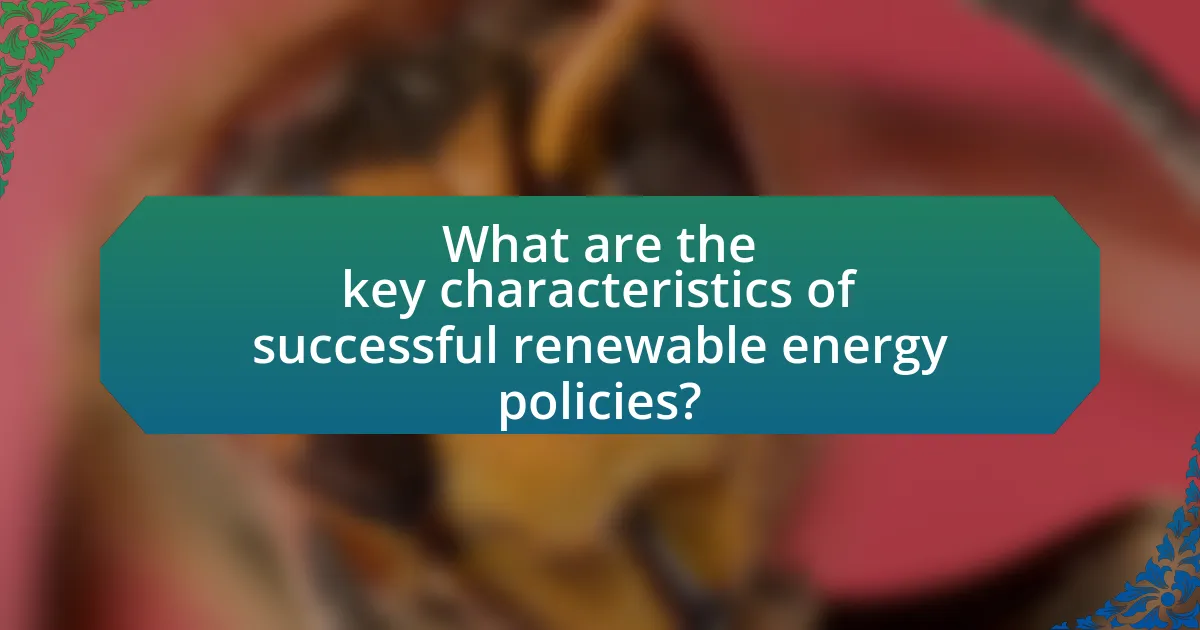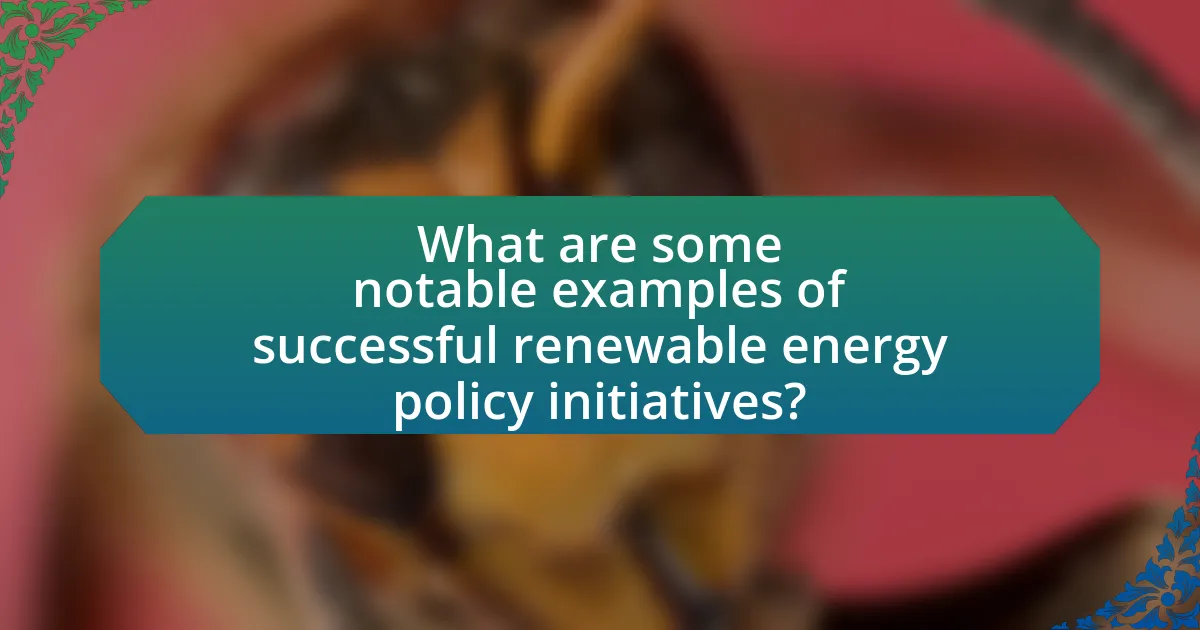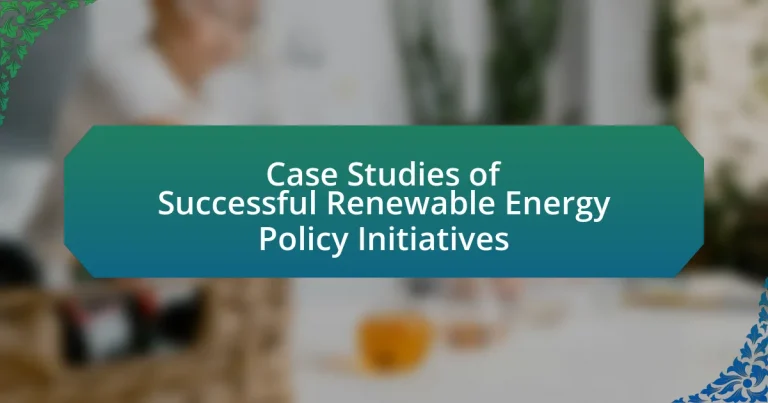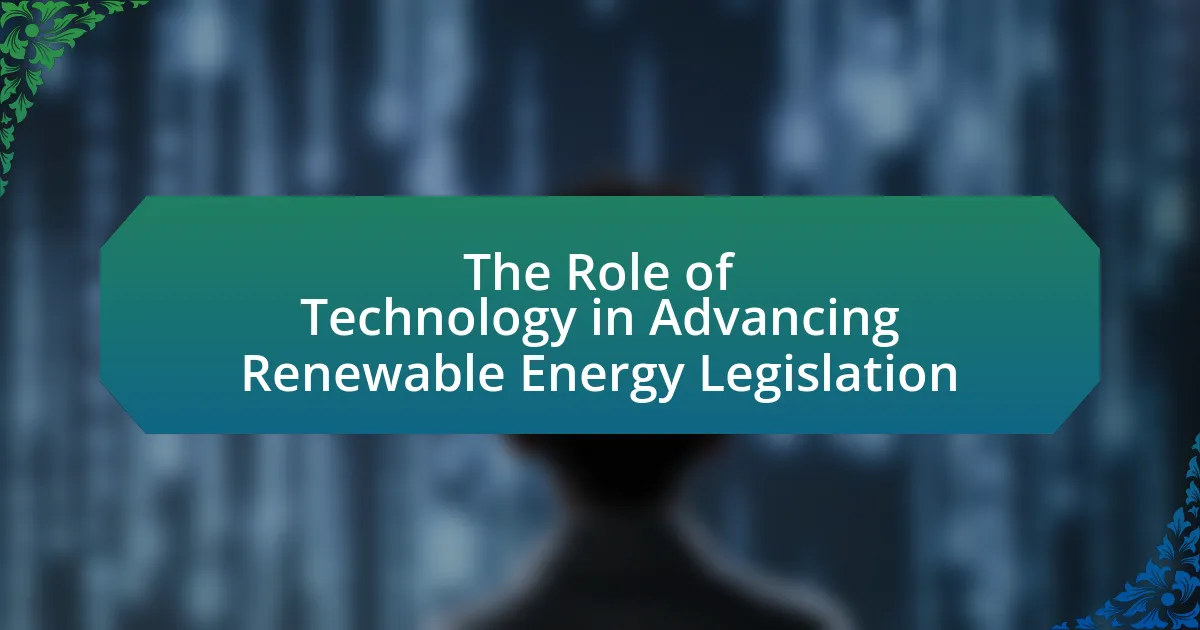The article focuses on case studies of successful renewable energy policy initiatives, highlighting notable examples such as Germany’s Energiewende, Denmark’s wind energy policies, and California’s Renewable Portfolio Standard. It examines how these initiatives illustrate effective policy implementation through measurable outcomes, specific policies like feed-in tariffs and renewable portfolio standards, and the impact of financial incentives on renewable energy adoption rates. Additionally, the article discusses the importance of stakeholder engagement, collaboration, and economic factors in shaping successful policies, providing practical strategies and best practices for policymakers to replicate these initiatives in different contexts.

What are Case Studies of Successful Renewable Energy Policy Initiatives?
Case studies of successful renewable energy policy initiatives include Germany’s Energiewende, which aims to transition to a sustainable energy system through significant investments in wind and solar power, resulting in renewable energy accounting for over 40% of its electricity consumption by 2020. Another example is Denmark’s wind energy policy, where government support and incentives led to wind power providing approximately 47% of the country’s electricity in 2019. Additionally, California’s Renewable Portfolio Standard mandates that 60% of the state’s electricity come from renewable sources by 2030, contributing to a significant reduction in greenhouse gas emissions. These initiatives demonstrate effective policy frameworks that promote renewable energy adoption and sustainability.
How do these case studies illustrate effective policy implementation?
These case studies illustrate effective policy implementation by demonstrating measurable outcomes in renewable energy adoption and sustainability. For instance, the case of Germany’s Energiewende policy showcases a systematic approach to transitioning to renewable energy, resulting in a significant increase in the share of renewables in electricity generation from 6% in 2000 to over 40% in 2019. This success is attributed to clear regulatory frameworks, financial incentives, and public engagement strategies that facilitated widespread acceptance and participation. Additionally, the California Renewable Portfolio Standard led to a tripling of renewable energy capacity from 2002 to 2018, underscoring the effectiveness of legally binding targets and market mechanisms in driving investment and innovation in clean energy technologies. These examples provide concrete evidence of how structured policies can lead to substantial advancements in renewable energy initiatives.
What specific policies were adopted in these case studies?
The specific policies adopted in the case studies of successful renewable energy initiatives include feed-in tariffs, renewable portfolio standards, and tax incentives for renewable energy investments. Feed-in tariffs guarantee fixed payments for energy producers who generate renewable energy, promoting investment in solar and wind technologies. Renewable portfolio standards require utilities to obtain a certain percentage of their energy from renewable sources, driving demand for clean energy. Tax incentives, such as investment tax credits and production tax credits, reduce the financial burden on developers and encourage the growth of renewable energy projects. These policies have been implemented in various regions, leading to significant increases in renewable energy capacity and reductions in greenhouse gas emissions.
How did these policies impact renewable energy adoption rates?
Renewable energy adoption rates increased significantly due to supportive policies. For instance, countries implementing feed-in tariffs and tax incentives saw a surge in solar and wind energy installations; Germany’s feed-in tariff policy led to a tenfold increase in solar capacity from 2000 to 2010. Additionally, renewable portfolio standards in the United States resulted in a 50% increase in renewable energy generation from 2000 to 2018. These policies created favorable market conditions, driving investment and innovation in renewable technologies, thereby accelerating adoption rates.
Why are case studies important for understanding renewable energy policies?
Case studies are important for understanding renewable energy policies because they provide real-world examples that illustrate the effectiveness and challenges of various policy initiatives. By analyzing specific cases, policymakers and researchers can identify best practices, assess the impact of different strategies, and understand the contextual factors that influence policy outcomes. For instance, the case study of Germany’s Energiewende demonstrates how comprehensive policy frameworks can lead to significant increases in renewable energy adoption, showcasing the importance of government support and public engagement in achieving energy transition goals.
What lessons can be learned from successful initiatives?
Successful initiatives in renewable energy policy demonstrate the importance of stakeholder engagement, clear objectives, and adaptive management. Stakeholder engagement ensures that diverse perspectives are considered, leading to broader support and more effective implementation. For instance, the California Renewable Portfolio Standard involved extensive collaboration with utilities, environmental groups, and the public, resulting in a robust framework that has significantly increased renewable energy generation. Clear objectives provide a roadmap for success; the European Union’s 20-20-20 targets set specific goals for reducing greenhouse gas emissions, increasing renewable energy, and improving energy efficiency, which have driven substantial progress. Adaptive management allows for flexibility in response to changing circumstances; the Feed-in Tariff scheme in Germany was adjusted over time based on market conditions and technological advancements, ensuring its continued effectiveness. These lessons highlight the critical factors that contribute to the success of renewable energy initiatives.
How do case studies contribute to policy development in other regions?
Case studies contribute to policy development in other regions by providing empirical evidence and practical insights that inform decision-making. They illustrate successful strategies and outcomes from specific contexts, allowing policymakers to adapt these lessons to their own regional challenges. For instance, the case study of Germany’s Energiewende demonstrates how comprehensive renewable energy policies can lead to significant reductions in greenhouse gas emissions and increased energy independence. This evidence encourages other regions to implement similar initiatives, tailoring them to local conditions while benefiting from proven methodologies.

What are the key characteristics of successful renewable energy policies?
Successful renewable energy policies are characterized by clear goals, strong regulatory frameworks, financial incentives, stakeholder engagement, and adaptability. Clear goals provide a defined direction for energy transition, while strong regulatory frameworks ensure compliance and stability in the market. Financial incentives, such as tax credits and subsidies, encourage investment in renewable technologies. Stakeholder engagement fosters collaboration among government, industry, and communities, enhancing public support and participation. Lastly, adaptability allows policies to evolve based on technological advancements and market changes, ensuring long-term effectiveness. These characteristics have been observed in successful initiatives like Germany’s Energiewende and California’s renewable energy programs, which have led to significant increases in renewable energy capacity and reductions in greenhouse gas emissions.
How do stakeholder engagement and collaboration influence policy success?
Stakeholder engagement and collaboration significantly enhance policy success by fostering inclusive decision-making and ensuring diverse perspectives are considered. When stakeholders, including community members, businesses, and government entities, actively participate in the policy development process, they contribute valuable insights that lead to more effective and widely accepted policies. For instance, the California Renewable Portfolio Standard, which mandates a certain percentage of energy from renewable sources, succeeded largely due to extensive stakeholder consultations that included utilities, environmental groups, and the public, resulting in a policy that balanced economic and environmental goals. This collaborative approach not only builds trust among stakeholders but also increases the likelihood of policy implementation and compliance, as stakeholders feel a sense of ownership over the outcomes.
What roles do government, industry, and community play in these initiatives?
Government, industry, and community each play crucial roles in renewable energy policy initiatives. Governments establish regulatory frameworks, provide funding, and create incentives to promote renewable energy adoption, as seen in countries like Germany, which implemented feed-in tariffs to boost solar energy production. Industry contributes by investing in technology development, manufacturing renewable energy systems, and deploying infrastructure, exemplified by companies like Tesla, which has advanced battery storage solutions. Communities engage by participating in local renewable energy projects, advocating for sustainable practices, and supporting initiatives that align with their environmental goals, as demonstrated by community solar programs in the United States that allow residents to invest in shared solar installations.
How can effective communication enhance stakeholder involvement?
Effective communication enhances stakeholder involvement by fostering transparency and building trust among all parties. When stakeholders are well-informed about project goals, processes, and potential impacts, they are more likely to engage actively and contribute valuable insights. For instance, research conducted by the International Renewable Energy Agency (IRENA) indicates that projects with robust communication strategies experience higher levels of stakeholder participation, leading to more successful outcomes. This correlation highlights that clear, consistent messaging not only informs stakeholders but also empowers them to take ownership of initiatives, ultimately driving collective success in renewable energy policy implementation.
What economic factors contribute to the success of renewable energy policies?
Economic factors that contribute to the success of renewable energy policies include government incentives, market demand for clean energy, and the decreasing costs of renewable technologies. Government incentives, such as tax credits and subsidies, stimulate investment in renewable energy projects, making them financially viable. Market demand for clean energy is driven by consumer preferences and corporate sustainability goals, which encourage the development of renewable energy sources. Additionally, the costs of technologies like solar and wind energy have significantly declined; for instance, the cost of solar photovoltaic systems dropped by about 82% from 2010 to 2019, according to the International Renewable Energy Agency. This combination of supportive policies, market dynamics, and technological advancements creates a favorable economic environment for the implementation and success of renewable energy initiatives.
How do financial incentives affect renewable energy investments?
Financial incentives significantly boost renewable energy investments by reducing the cost burden on developers and investors. These incentives, such as tax credits, grants, and subsidies, lower the initial capital required for projects, making them more attractive. For instance, the U.S. Investment Tax Credit (ITC) has historically led to a surge in solar energy installations, with a reported increase of over 10,000% in capacity from 2006 to 2020, demonstrating the direct correlation between financial incentives and investment growth in the sector.
What is the role of market conditions in shaping policy outcomes?
Market conditions play a crucial role in shaping policy outcomes by influencing the feasibility and attractiveness of various policy options. For instance, favorable market conditions, such as low costs for renewable energy technologies, can lead to the adoption of supportive policies that promote investment in renewable energy sources. A concrete example is the significant decline in solar panel prices, which has prompted governments worldwide to implement incentives and subsidies for solar energy adoption, resulting in increased capacity and deployment. According to the International Renewable Energy Agency (IRENA), the global weighted-average cost of electricity from solar photovoltaics fell by 89% between 2009 and 2020, directly impacting policy decisions favoring renewable energy initiatives.

What are some notable examples of successful renewable energy policy initiatives?
Some notable examples of successful renewable energy policy initiatives include Germany’s Energiewende, California’s Renewable Portfolio Standard, and Denmark’s wind energy policies. Germany’s Energiewende, initiated in 2010, aims to transition to a sustainable energy system, resulting in renewable energy accounting for over 40% of its electricity generation by 2020. California’s Renewable Portfolio Standard mandates that 60% of the state’s electricity must come from renewable sources by 2030, significantly increasing solar and wind energy deployment. Denmark’s policies have made it a leader in wind energy, with wind turbines generating about 47% of the country’s electricity in 2019, supported by government incentives and a strong regulatory framework.
How did Germany’s Energiewende transform its energy landscape?
Germany’s Energiewende transformed its energy landscape by significantly increasing the share of renewable energy sources in its electricity generation. As of 2021, renewables accounted for approximately 42% of Germany’s total electricity consumption, up from just 6% in 2000. This transition was driven by policies such as the Renewable Energy Sources Act (EEG), which incentivized the development of wind, solar, and biomass energy. The shift not only reduced greenhouse gas emissions but also led to a decline in coal usage, with coal-fired power generation dropping by about 40% between 2012 and 2020. Additionally, the Energiewende fostered technological innovation and job creation in the renewable sector, with over 300,000 jobs linked to renewable energy by 2020.
What specific measures were implemented in Germany’s policy framework?
Germany implemented specific measures in its policy framework, including the Renewable Energy Sources Act (EEG), which established feed-in tariffs to incentivize renewable energy production. This act guaranteed fixed payments for energy producers, promoting investments in solar, wind, and biomass energy. Additionally, Germany introduced the Energy Concept in 2010, aiming for a significant reduction in greenhouse gas emissions and a transition to a sustainable energy system by 2050. The country also established the “Energiewende” initiative, focusing on energy efficiency, grid expansion, and the phase-out of nuclear energy. These measures collectively contributed to Germany becoming a leader in renewable energy adoption, with renewables accounting for over 40% of its electricity consumption by 2020.
What outcomes have resulted from Germany’s renewable energy transition?
Germany’s renewable energy transition has resulted in a significant reduction in greenhouse gas emissions, achieving a decrease of approximately 40% from 1990 levels by 2020. This transition has led to the generation of over 40% of the country’s electricity from renewable sources, primarily wind and solar energy, as reported by the Federal Ministry for Economic Affairs and Energy. Additionally, the shift has created around 300,000 jobs in the renewable energy sector, contributing to economic growth and energy independence. The Energiewende policy framework has also stimulated technological innovation and investment in clean energy technologies, positioning Germany as a leader in the global renewable energy market.
What lessons can be drawn from Denmark’s wind energy policies?
Denmark’s wind energy policies demonstrate the effectiveness of long-term government commitment and investment in renewable energy infrastructure. The Danish government initiated a comprehensive strategy in the 1980s, which included financial incentives for wind energy development, resulting in wind power contributing to approximately 47% of the country’s electricity consumption by 2020. This success is attributed to a combination of supportive legislation, public-private partnerships, and a focus on technological innovation, which collectively fostered a robust wind energy sector. The Danish experience illustrates that consistent policy frameworks and stakeholder collaboration are crucial for scaling renewable energy solutions effectively.
How did Denmark achieve its leadership in wind energy production?
Denmark achieved its leadership in wind energy production through a combination of strong government policies, significant investments in research and development, and a commitment to renewable energy. The Danish government implemented favorable policies in the 1980s, including feed-in tariffs and subsidies, which incentivized the development and installation of wind turbines. By 2020, wind energy accounted for approximately 47% of Denmark’s total electricity consumption, showcasing the effectiveness of these policies. Additionally, Denmark’s focus on innovation led to the establishment of leading wind turbine manufacturers, such as Vestas and Siemens Gamesa, further solidifying its position in the global wind energy market.
What challenges did Denmark face during its policy implementation?
Denmark faced several challenges during its policy implementation for renewable energy initiatives, primarily including political consensus, public acceptance, and technological integration. Political consensus was difficult to achieve due to varying interests among stakeholders, which slowed decision-making processes. Public acceptance posed a challenge as some communities resisted the installation of wind turbines and other renewable infrastructure, fearing impacts on local landscapes and property values. Additionally, integrating new technologies into the existing energy grid required significant investment and coordination, complicating the transition to renewable sources. These challenges were documented in various studies, including the International Energy Agency’s report on Denmark’s energy policies, which highlighted the importance of addressing stakeholder concerns and ensuring robust infrastructure to support renewable energy growth.
What practical strategies can be adopted from these case studies?
Practical strategies that can be adopted from case studies of successful renewable energy policy initiatives include implementing comprehensive policy frameworks, fostering public-private partnerships, and investing in education and training programs. Comprehensive policy frameworks, such as those seen in Germany’s Energiewende, provide clear guidelines and incentives that drive renewable energy adoption. Public-private partnerships, exemplified by Denmark’s wind energy sector, leverage resources and expertise from both sectors to enhance project viability and innovation. Additionally, investing in education and training programs, as demonstrated in California’s clean energy initiatives, equips the workforce with necessary skills, ensuring sustainable growth in the renewable energy sector. These strategies have proven effective in various contexts, leading to increased renewable energy deployment and economic benefits.
How can policymakers replicate successful initiatives in different contexts?
Policymakers can replicate successful initiatives in different contexts by conducting thorough assessments of the original initiative’s components, understanding the local context, and adapting strategies accordingly. For instance, the implementation of feed-in tariffs in Germany led to significant renewable energy growth; policymakers in other countries can analyze the tariff structure, regulatory environment, and stakeholder engagement strategies that contributed to its success. Additionally, they should consider local economic, social, and environmental factors to ensure that adaptations align with community needs and capacities. Evidence from various countries, such as Spain and Denmark, demonstrates that tailored approaches based on successful models can lead to effective policy outcomes in diverse settings.
What best practices should be considered when designing renewable energy policies?
Best practices for designing renewable energy policies include establishing clear goals, ensuring stakeholder engagement, and implementing flexible regulatory frameworks. Clear goals provide direction and measurable outcomes, as seen in Germany’s Energiewende, which aimed for a significant increase in renewable energy share by 2020. Stakeholder engagement fosters collaboration and acceptance, exemplified by Denmark’s wind energy initiatives, where local communities were involved in decision-making processes. Flexible regulatory frameworks allow for adaptation to technological advancements and market changes, as demonstrated by California’s evolving renewable portfolio standards, which have been adjusted to meet new challenges and opportunities in the energy sector.




